Guide to garden fencing
Guide to garden fencing
Introduction
Garden fencing offers privacy and security and can create a lovely aesthetic for an outdoor space. But, before you buy, there are a few things to consider. From what style to choose and the type of fence posts you need to how they will be installed.
This guide tells you everything you need to know about garden fencing. It covers the different types of fence panels and fence posts available. It talks about what’s involved in installing fencing and how to calculate the number of fence panels you need. It also gives guidance on choosing a garden gate and highlights some things to consider before buying.
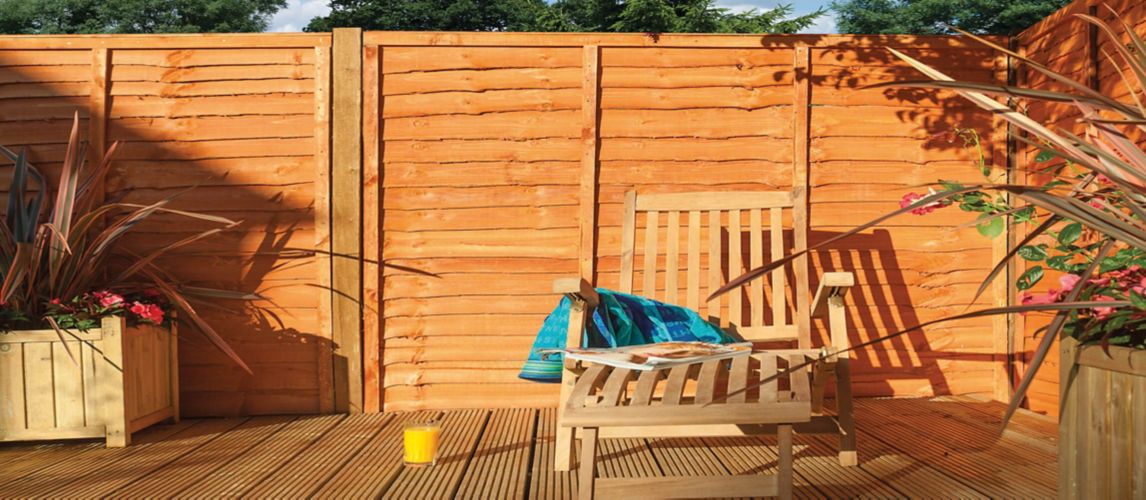
Types of Garden Fencing
Wood is the most common material for garden fencing because its natural appearance is ideal for a natural environment. It comes in many styles, so you can choose depending on taste, budget and the level of privacy and security you need.
Here, we look at the most common types of garden fencing.
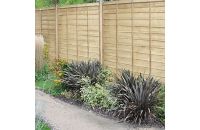
- Lap fence panels
Lap fence panels are constructed from a wooden framework into which slats are slotted horizontally. The slats overlap slightly, leaving no gaps, forming a solid boundary fence that offers high levels of privacy.
These fence panels are traditional in design, making them suitable for any type of garden. They are one of the cheapest fence panels and are not as strong as other types. However, they will last for many years if they are well maintained.
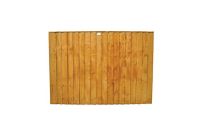
- Feather edge fence panels
Feather edge fence panels are constructed from a wooden frame onto which slats are fixed vertically, hiding the frame. The slats overlap slightly, leaving no gaps to provide privacy. Battens are secured horizontally across the back of the fence to add stability and ensure the fence panel is rigid and durable.
These fence panels are traditional in design, making them suitable for any type of garden. They are also one of the cheapest fence panels, but they are stronger than lap fence panels. They can be erected as individual panels or constructed on site, slat by slat, making them more versatile for coping with level changes in a garden.
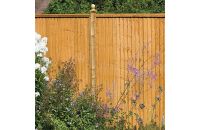
- Closeboard fence panels
Closeboard fence panels are constructed from a heavy-duty wooden frame. Slats are inserted vertically, leaving the frame visible. The slats overlap slightly, leaving no gaps to offer a high level of privacy. Unlike feather edge fence panels, closeboard panels don’t have horizontal battens across the back. This makes them more secure because there’s nothing for intruders to use as a foothold to help them climb over.
These fence panels are traditional in design, making them suitable for any type of garden.
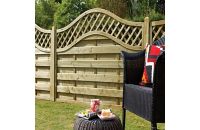
- Decorative fence panels
Decorative fence panels are constructed from a wooden frame and come in many different designs. For example, double-slatted fence panels have horizontal slats alternating from the front to the back of the panel. Venetian fence panels have horizontal slats with small gaps between them. Then there are Louvre panels which are similar to Venetian panels, except the slats are tilted.
Decorative fence panels provide a stylish and contemporary look to a garden. Some offer more privacy than others, depending on whether there are gaps in the panel or not. And they can be used for border fencing or as a decorative screen within a garden to section off areas and create individual spaces.

- Lattice fence panels
Lattice fence panels are constructed with a wooden frame with a criss-cross trellis at the top. The lower part of the panel has horizontal and vertical slats weaving in and out, which gives them increased strength and durability.
The panels are decorative in style and are great for creating an attractive border and additional privacy. The trellis top allows sunlight through and can be used to support plants.
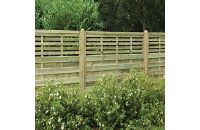
- Slatted Fence Panels
Slatted fence panels are made up of horizontal timber to create a decorative high-quality screen design. Usually made from pressure-treated softwood and smooth-planned timber with mortise and tenon jointed frames for security and strength. They are a modern style that has grown in popularity. Options include different widths, heights and those with just a slatted top half.
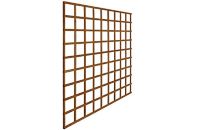
- Other fence panels
The fence panels above are the most popular types, but there are plenty of others. For example, picket fence panels are a traditional style, distinguished by their evenly spaced vertical boards with pointed tops attached to a horizontal batten or rail. Tongue and groove fence panels are made up of flat slats of timber that are slotted together to provide a traditional look.
There are also noise reduction fence panels designed to reflect, diffuse and absorb noise. They can reduce noise levels by up to 30dB, so they’re ideal if the house is near a busy road. Then there is electric fencing that provides safe and secure boundaries for livestock or keeps out predators. Electric fencing can be fixed in place permanently or used as a temporary measure because it can be erected and taken down quickly.
Garden Fence Panel Treatment Options
New garden fence panels come pre-treated to help them withstand the elements. They are either dip-treated or pressure-treated.
This section describes the two treatment options and their pros and cons.
- Dip-treated fence panels
Dip-treated fence panels are immersed in a bath of timber treatment and are then removed and left to dry. The treatment often contains a dye to enhance the colour of the wood.
The pros of dip-treatment are that it offers protection against water damage, insects and fungal decay. And fence panels with this treatment tend to be cheaper than pressure-treated fence panels.
The cons of dip-treatment are that the treatment is only applied to the outer layer of the timber, and it quickly wears off. So, the fence will need to be treated annually with a suitable fence treatment after its first year.
- Pressure-treated fence panels
Pressure-treated fence panels are treated using a vacuum pressure method that forces timber preservatives deep into the wood. This method has no dye, so the wood is left in its original colour.
The pros of pressure treatment are similar to those of dip treatment. It also offers protection against water damage, insects, and fungal decay. However, as the preservative is deep inside the wood, the benefits can last for up to 15 years. The fence panel will still need to be re-treated, but not for the first few years, and then only every 2-3 years after that.
The only con to pressure-treated fence panels is the cost, as they tend to be more expensive than dip-treated panels. However, with less maintenance and a longer lifespan, that extra cost can be recouped over the years.
Choosing Fence Posts
Fence posts are an essential part of a fencing project. They act as the backbone of the whole structure, keeping it upright and supporting it to withstand the elements. So, getting the right fence posts to suit your project is vital.
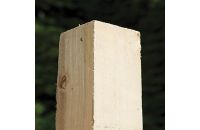
This section describes the two available types of fence posts, wooden and concrete, and looks at their pros and cons. Metal fence posts are also another option available.
- Wooden fence posts
Wooden fence posts are made from either hardwood or softwood, with hardwood being the most durable. The wood is pressure-treated to protect against water damage, insects and fungal decay. Most wooden fence posts require the fence panels to be attached using special fixings. But there are slotted versions that allow fence panels to simply be slotted in, with no fixings needed.
The pros of wooden fence posts are that they match the fence panels, which can look more natural and pleasing than concrete posts. They’re also light and easy to handle, making installation quicker and more straightforward. They cost less than concrete fence posts too.
The cons of wooden fence posts are that they need to be treated with fence paint every 2-3 years to keep them looking their best and prolong their life. And, as they are buried in the ground, they’re prone to rotting and being blown down in strong winds. However, those risks can be reduced by using metal or plastic post supports.
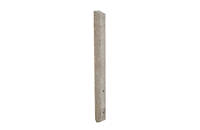
- Concrete fence posts
Concrete fence posts are made of solid concrete. They have a slotted design that allows fence panels to simply be slotted in, with no fixings needed.
The pros of concrete fence posts are that they are extremely strong and highly wind-resistant. They provide a more robust and more stable structure for fencing than wooden fence posts. They’re unaffected by moisture and rot, giving years of life, and they’re maintenance-free. And although concrete is heavier than wood, most concrete fence posts are manufactured to be lightweight for safe and easy handling and quick installation.
The cons of concrete fence posts are that they are grey and therefore don’t match the fence panels. They’re also more expensive than wooden fence posts but will last much longer.
Choosing a Garden Gate

Garden gates can be both functional and stylish, helping to finish off the look of a property and provide security and privacy. They come in many designs and sizes, so you can choose depending on taste, budget, and the level of privacy and security you need.
One thing to consider is where the gate will be placed. If it’s at the back of the garden, adjacent to fence panels, the best solution is to buy a gate that matches the fence, so it blends in seamlessly. If the gate is at the side of the house, opt for a tall gate to make the garden more secure and a solid gate for privacy. A gate at the front of a home should be no taller than 1m high if it’s next to a road. So, as privacy and security are less of a factor here, you could choose a decorative gate or one with gaps in the panel, such as a picket gate.
Before buying a gate, also think about the installation. When considering its width, allow for fence posts if they aren’t already in place. And when considering its height, ensure there will be enough ground clearance for the gate to swing open. Also, decide if it needs to be hinged from the left or right-hand side? Many gates can be hung from either side. But a heavy-duty gate may need to be hung on a specific side for added support.
Garden Fence Installation
Installation of fencing is often a simple job for an experienced DIYer. Especially if it only involves swapping an old fence panel for a new one. But the job may be more complex if a long run of fencing is being replaced, if fence posts are being installed, or if the garden is sloped or an awkward shape. In these cases, you may need a professional installer.
There are a few things to consider when installing fencing. For example:
-
Do you need to install fence posts? If the old posts are rotting or rickety, then new posts are recommended. And, if you install fence posts in a new position, it’s essential to check the location of any water pipes or power cables before digging any holes.
-
Carefully check the measurements are correct for the fences you need. The standard width of a fence panel is 1.8m. Then you need to take the width of the fence posts into account. And depending on the length of the run, you may need to cut a fence panel down and repair the frame to fit the space.
-
If the garden is sloped, you’ll need to consider whether the slope is gentle enough to use standard fence panels and step them at regular intervals. Or would it be easier for a professional to build the fence in situ?
The installation of garden fencing typically involves:
-
Removing the old fence panels
-
Removing the old fence posts (if you’re replacing them)
-
Measuring up and marking where fence posts will go
-
Fixing the fence posts in place. This could involve digging holes and concreting the posts in
-
Fixing the fence panels in place, either with fixings or by slotting the panels in, depending on the type of fence posts used
-
If there are gaps at the bottom of the fence panels, you may need to install gravel boards.
The amount of time it takes to install fencing depends on the number of fence panels, whether fence posts are being installed, the fitter’s level of expertise, and the job’s complexity. However, as a rough guide, it would take a skilled professional one to two days (allowing for the concrete to set) to install a 10-metre run of fencing, including posts, on flat ground.
Fencing supplies
In addition to fence panels and posts, you'll need some other fencing supplies, tools, and equipment to complete the project.
Here’s a handy list of all the things you may need.
-
Tape measure
-
Cable and pipe detector
-
Bamboo cane and string (to mark out the fence line and post positions)
-
Fence post hole digger
-
Post rammer
-
Timber preservative (to soak the ends of wooden fence posts before installing)
-
Fence post supports or spikes (for use with wooden fence posts)
-
Concrete or postcrete (for use with concrete or wooden fence posts)
-
Dust mask, safety goggles and protective gloves (if using postcrete)
-
Trowel
-
Spirit level
-
Wood saw
-
Fence fixings (i.e., brackets, joiners or clips)
-
Exterior grade screws
-
Screwdriver
-
Gravel boards
-
Post caps
How to Calculate the Number of Fence Panels Needed
The number of fence panels you need will depend on the length of the fencing run and the width of the fence panels.
Follow this guide to calculate how many fence panels you need. It works no matter whether you’re using standard-sized fence panels (1.8m width) or bespoke size, as long as all the panels are the same:
- Length of fencing run minus the width of a gate (if applicable), divided by the fence panel width (measure in metres).
- The final number will be slightly more than you need as there will be a fence post between each panel to accommodate. You may also find you have to reduce the size of one panel if you don’t get an exact fit.
- Fence panels are sold separately or in packs with varying quantities. So, remember to check the pack size when you buy to ensure you get the correct amount.
What to Consider When Buying Garden Fencing
We’ve covered the most essential information about fencing above, but here are a few more things to consider before you buy:
-
Do you need to replace garden fence panels?
Before replacing fencing, it’s worth checking that it really does need to be replaced or if it can be restored with fence paint. Signs that a fence needs replacing include a leaning fence, rotting wood, crumbling concrete posts, and missing or split slats. And, of course, fencing can be replaced as part of a garden makeover. -
How high can a garden fence be?
Any boundary fence next to a road should be no more than 1m high, and in all other areas, it should be no more than 2m high, including any trellis on the top of the fence. Planning permission is required to erect a fence any higher than that. -
Who is responsible for a garden fence?
Homeowners are responsible for their own garden fences. But if a fence marks a boundary between two homes, that fence will belong to only one of those homeowners. To check who owns a garden fence, look at the property’s title deeds (you can get a copy from Land Registry if you don’t have one). The boundary fence will be marked with a T on the plan, with the stem of the T pointing in the direction of the boundary owner. -
How do you secure fence panels?
Fence panels can be secured in two ways. First, you can use slotted fence posts in which the fence panel simply slides into place with no fixings needed. Alternatively, with wooden fence posts, use metal fencing brackets. The brackets are screwed to the top, middle, and bottom of the fence post in a line and then the fence panel is slid down through the brackets to hold it in place.
